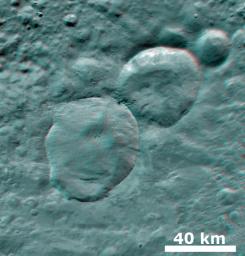3-D Image of Fresh Craters
Caption:
This 3-D image, called an anaglyph, shows three fresh craters, which have been nicknamed the 'Snowman' craters. Each crater has now been given an official name: the largest is called Marcia, the middle is called Calpurnia and the smallest is called Minucia. To create this anaglyph, two differently colored images are superimposed with an offset to create depth. When viewed through red-blue glasses this anaglyph shows a 3-D view of Vesta's surface. The depth effect in this anaglyph, derived from topography differences, was calculated from the shape model of Vesta. Marcia, Calpurnia and Minucia have sharp, fresh crater rims and a smooth area of ejecta, called an ejecta blanket, surrounding them. These features are distinctive in this image.
The images used to generate the anaglyph are located in Vesta's Marcia quadrangle and the center is 12 degrees north latitude, 194 degrees east longitude. NASA's Dawn spacecraft obtained this image with its framing camera on Jul. 24, 2011. This image was taken through the camera's clear filter. The distance to the surface of Vesta is 5,200 kilometers (3,231 miles) and the image has a resolution of about 485 meters (1,591 feet) per pixel. This image was acquired during the approach phase of the mission.
Background Info:
The Dawn mission to Vesta and Ceres is managed by NASA's Jet Propulsion Laboratory, a division of the California Institute of Technology in Pasadena, for NASA's Science Mission Directorate, Washington D.C. UCLA is responsible for overall Dawn mission science. The Dawn framing cameras have been developed and built under the leadership of the Max Planck Institute for Solar System Research, Katlenburg-Lindau, Germany, with significant contributions by DLR German Aerospace Center, Institute of Planetary Research, Berlin, and in coordination with the Institute of Computer and Communication Network Engineering, Braunschweig. The Framing Camera project is funded by the Max Planck Society, DLR, and NASA/JPL.
More information about the Dawn mission is online at
http://www.nasa.gov/dawn
and
http://dawn.jpl.nasa.gov
.
Cataloging Keywords:
| Name |
Value |
Additional Values |
| Target |
4 Vesta |
|
| System |
Main Belt |
|
| Target Type |
Asteroid |
|
| Mission |
Dawn |
|
| Instrument Host |
Dawn |
|
| Host Type |
Orbiter |
|
| Instrument |
Framing Camera (FC) |
|
| Detector |
|
|
| Extra Keywords |
Color, Crater |
| Acquisition Date |
|
| Release Date |
2012-03-08 |
| Date in Caption |
2011-07-24 |
|
| Image Credit |
NASA/JPL-Caltech/UCLA/MPS/DLR/IDA |
| Source |
photojournal.jpl.nasa.gov/catalog/PIA15453 |
| Identifier |
PIA15453 |

 Planetary Data System
Planetary Data System
